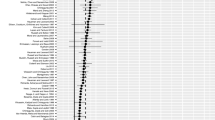Abstract
A new price model that characterizes the transfer of demands between products through the concept of product networks is proposed. Via replacing the basic unit: pairs of products, to be used when considering the relationships between demands and prices of different products, with networks, the proposed model requires less observations to calibrate. Therefore, considering all the substitute products in the proposed model in analyzing price elasticity is possible. The feasibility of the proposed approach is demonstrated in its application to data from two North American grocery stores.
Similar content being viewed by others
Change history
01 April 2022
Formatting of the tables were inconsistent and tables have been corrected
References
Agrawal, V., and M. Ferguson. 2007. Bid-response models for customised pricing. Journal of Revenue and Pricing Management 6 (3): 212–228.
Chen, X., and D. Simchi-Levi. 2004. Coordinating inventory control and pricing strategies with random demand and fixed ordering cost: The finite horizon case. Operations Research 52 (6): 887–896.
González-Benito, Ó., M.P. Martínez-Ruiz, and A. Mollá-Descals. 2010. Retail pricing decisions and product category competitive structure. Decision Support Systems 49 (1): 110–119.
Grewal, D., K. L. Ailawadi, D. Gauri, K. Hall, P. Kopalle, and J. R. Robertson. (2011). Innovations in retail pricing and promotions. Journal of Retailing, 87:S43–S52. Innovations in Retailing.
Grewal, D., R. Janakiraman, K. Kalyanam, P. Kannan, B. Ratchford, R. Song, and S. Tolerico. (2010). Strategic online and offline retail pricing: A review and research agenda. Journal of Interactive Marketing, 24(2):138–154. Special Issue on “Emerging Perspectives on Marketing in a Multichannel and Multimedia Retailing Enviroment”.
Guadagni, P.M., and J.D.C. Little. 1983. A logit model of brand choice calibrated on scanner data. Marketing Science 2 (3): 203–238.
Hoffman, K., L. Turley, and S.W. Kelley. 2002. Pricing retail services. Journal of Business Research 55 (12): 1015–1023.
Hosken, D., and D. Reiffen. 2004. Patterns of retail price variation. The RAND Journal of Economics 35 (1): 128–146.
Huang, J., M. Leng, and M. Parlar. 2013. Demand functions in decision modeling: A comprehensive survey and research directions. Decision Sciences 44 (3): 557–609.
Kalyanam, K. 1996. Pricing decisions under demand uncertainty: A Bayesian mixture model approach. Marketing Science 15 (3): 207–221.
Kim, B.-D., R.C. Blattberg, and P.E. Rossi. 1995. Modeling the distribution of price sensitivity and implications for optimal retail pricing. Journal of Business & Economic Statistics 13 (3): 291–303.
Kocabıyıkoğlu, A., and I. Popescu. 2011. An elasticity approach to the newsvendor with price-sensitive demand. Operations Research 59 (2): 301–312.
Kök, A. G., M. L. Fisher, and R. Vaidyanathan. (2008). Assortment planning: Review of literature and industry practice. Retail Supply Chain Management, pp. 99–153.
Kunz, T. P. and Crone, S. F. (2014). Demand models for the static retail price optimization problem—A Revenue Management perspective. In Granado, P. C. D., Joyce-Moniz, M., and Ravizza, S., editors, 4th Student conference on operational research, vol. 37 of OpenAccess Series in Informatics (OASIcs), pp. 101–125, Dagstuhl, Germany. Schloss Dagstuhl–Leibniz-Zentrum fuer Informatik.
Levy, M., D. Grewal, P. K. Kopalle, and J. D. Hess. (2004). Emerging trends in retail pricing practice: Implications for research. Journal of Retailing, 80(3):xiii–xxi.
Phillips, R. 2005. Pricing and Revenue Optimization. Stanford Business Books. Stanford: Stanford University Press.
Reibstein, D.J., and H. Gatignon. 1984. Optimal product line pricing: The influence of elasticities and cross-elasticities. Journal of Marketing Research 21 (3): 259–267.
Shin, H., S. Park, E. Lee, and W. Benton. 2015. A classification of the literature on the planning of substitutable products. European Journal of Operational Research 246 (3): 686–699.
Song, Y., S. Ray, and S. Li. 2008. Structural properties of buyback contracts for price-setting newsvendors. Manufacturing & Service Operations Management 10 (1): 1–18.
Strauss, A.K., R. Klein, and C. Steinhardt. 2018. A review of choice-based revenue management: Theory and methods. European Journal of Operational Research 271 (2): 375–387.
van Ryzin, G.J. 2005. Models of Demand. The Oxford Handbook of Pricing Management. Oxford: Oxford University Press.
Walters, R.G. 1991. Assessing the impact of retail price promotions on product substitution, complementary purchase, and interstore sales displacement. Journal of Marketing 55 (2): 17–28.
Wildt, A.R. 1977. Estimating models of seasonal market response using dummy variables. Journal of Marketing Research 14 (1): 34–41.
Author information
Authors and Affiliations
Corresponding author
Additional information
Publisher's Note
Springer Nature remains neutral with regard to jurisdictional claims in published maps and institutional affiliations.
Rights and permissions
About this article
Cite this article
Chen, HW., Lim, A. A network price elasticity of demand model with product substitution. J Revenue Pricing Manag 22, 235–247 (2023). https://doi.org/10.1057/s41272-022-00375-w
Received:
Accepted:
Published:
Issue Date:
DOI: https://doi.org/10.1057/s41272-022-00375-w




